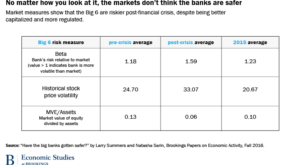More discussion about falling employment of young men in the US: John Rust publicizes the facts in a speech: Unskilled young men spend more time playing video games and less time in the labor market. “In 2015, 22 percent of lower-skilled men aged 21–30 had not worked at all during the prior 12 months.” They live in the basement of their parents’ houses and are not married. (And on his 12-year old son: “If we didn’t ration video games, I am not sure he would ever eat. I am positive he...
Read More »Have Banks Become Less Risky?
In BPEA, Natasha Sarin and Larry Summers argue that bank stock has not: … we find that financial market information provides little support for the view that major institutions are significantly safer than they were before the crisis and some support for the notion that risks have actually increased. … … financial markets may have underestimated risk prior to the crisis … Yet we believe that the main reason for our findings is that regulatory measures that have increased safety have been...
Read More »Redistribution From Unexpected Deflation in the Euro Area
In the JEEA 14(4) (August 2016) Klaus Adam and Junyi Zhu argue that unexpected price-level movements generate sizable wealth redistribution in the Euro Area (EA) … The EA as a whole is a net loser of unexpected price-level decreases, with Italy, Greece, Portugal, and Spain losing most in per capita terms, and Belgium and Malta being net winners. Governments are net losers of deflation, while the household (HH) sector is a net winner … HHs in Belgium, Ireland, Malta, and Germany experience...
Read More »Who Will Be the Next U.S. President?
The New York Times’ Upshot. Currently the odds are 3/4 to 1/4.
Read More »Dynamics of the World Income Distribution
In a Resolution Foundation report, Adam Corlett examines the “Elephant Curve.” The curve shows that between 1988 and 2008 income growth in the 70th to 95th percentile range of the world income distribution was much lower than for almost all other percentiles. Since the lower middle class of rich countries is situated around the 80th percentile of the distribution the Elephant curve has been interpreted as evidence for stagnating middle class incomes in the rich countries. Corlett...
Read More »Negative Interest Rates vs. Higher Inflation
On his blog, Ben Bernanke weighs the pros and cons of negative (nominal) interest rates vs. a higher inflation target to create monetary “policy space.” His main points are: Lower rates work immediately. In contrast, a higher inflation target only works once agents’ expectations adjust. A higher target may not be politically tenable a thus, not be credible. In contrast, “institutional changes … [such] as eliminating or restricting the issuance of large-denomination currency, could expand...
Read More »Homeopathy
The Economist is very sceptical.
Read More »Monetary Policy When Interest Rates are Near Zero
In the 18th Geneva Report on the World Economy, Laurence Ball, Joseph Gagnon, Patrick Honohan and Signe Krogstrup ask whether “central banks can do [more] to provide stimulus when rates are near zero; and … whether policies exist that would lessen future constraints from the lower bound.” They are optimistic and argue that the unconventional policies of recent years can be extended: “[I]t is likely that rates could go somewhat further than what has been done so far without adverse...
Read More »Banking on the Blockchain
In the NZZ, Axel Lehmann offers his views on the prospects of blockchain technologies in banking. Lehmann is Group Chief Operating Officer of UBS Group AG. New possibilities: Higher efficiency; lower cost; more robustness and simpler processes; real-time clearing; no need for intermediaries; information exchange without risk of interference automated “smart contracts;” automated wealth management; more control over transactions; better data protection; improved possibilities for macro...
Read More »Chile’s Fully Funded Pension System
On Project Syndicate, Andres Velasco argues that one of the sources of the current problems with the Chilean pension system are the high fees charged by fund managers: A government-appointed commission recently concluded that managers have generated high gross real returns on investments: from 1981 to 2013, the annual average was 8.6%; but high fees cut net returns to savers to around 3% per year over that period. The commission’s report.
Read More » Swiss Economicblogs.org
Swiss Economicblogs.org

